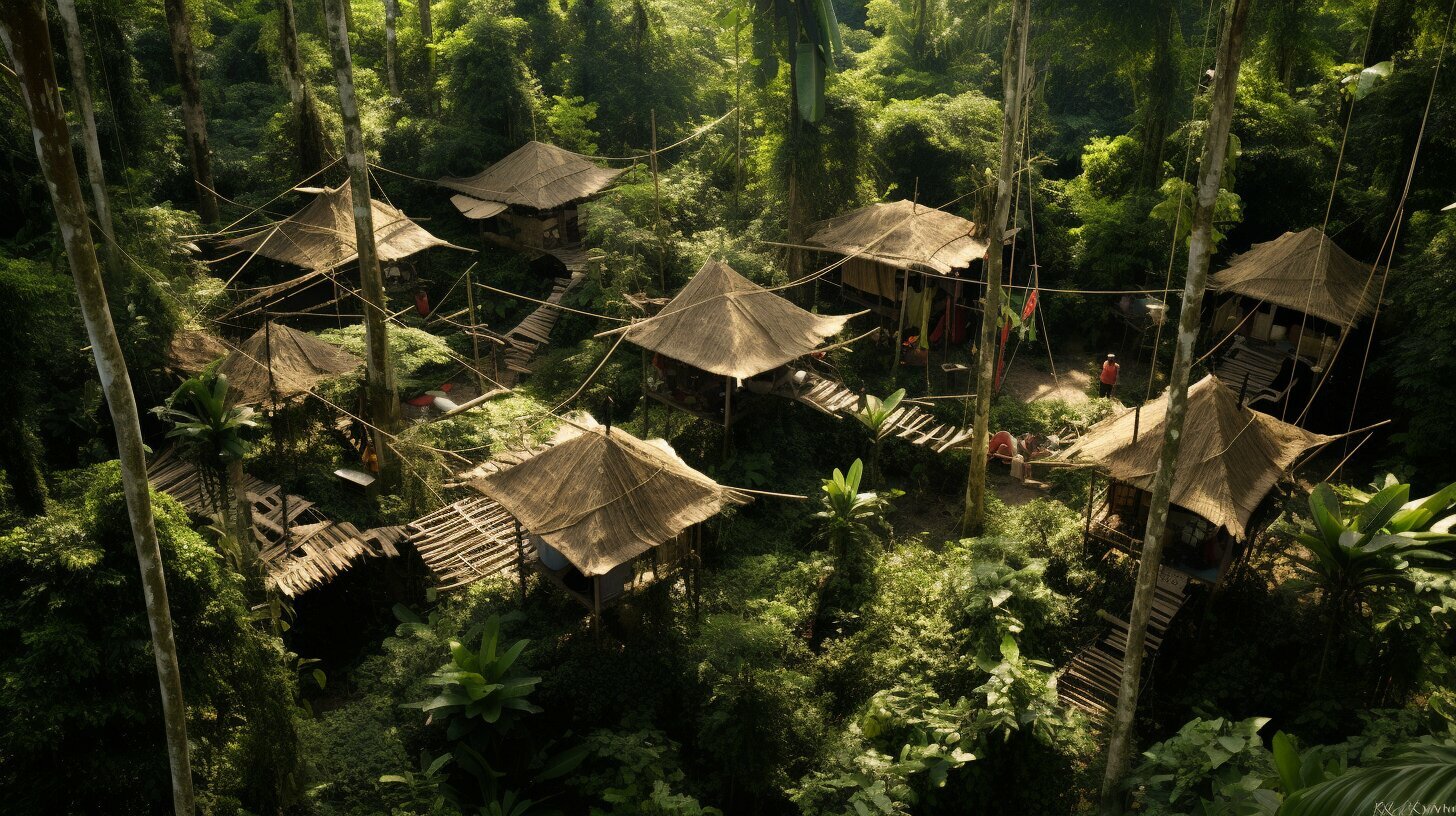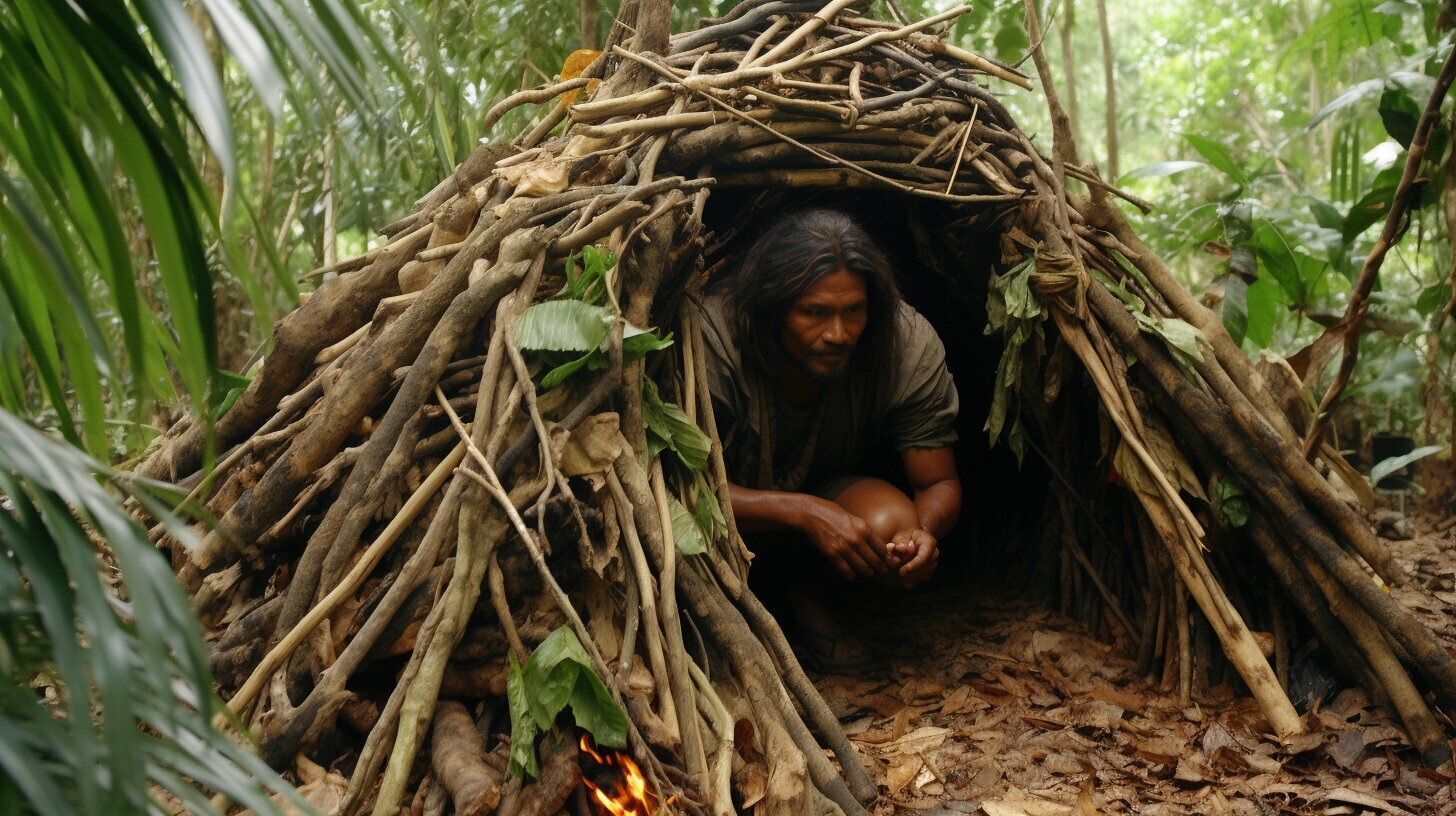When you venture into the jungle, you expose yourself to a variety of hazards. From extreme weather conditions to wild animals and insects, the jungle can be an unforgiving environment. One of the most crucial things you need to survive in the jungle is a shelter. Different types of jungle shelters can protect you from the elements and provide a safe space to rest and recharge.
Whether you are an avid adventurer or just love spending time in nature, knowing how to build a jungle shelter can be the difference between life and death. In this article, we will explore various jungle shelter types and the best techniques for building them. We will also discuss the importance of eco-friendly and sustainable shelter options that help preserve the jungle’s natural beauty.
Disclosure: When you buy through links on our site, we may earn an affiliate commission.
Key Takeaways
- Jungle shelters are essential for your survival in the wilderness.
- There are different types of jungle shelters to suit your needs and preferences.
- By building eco-friendly and sustainable shelters, you can minimize your impact on the environment.
- Knowing the techniques for building a jungle shelter will help ensure your safety and comfort.
- Consider the advantages and disadvantages of different jungle shelters with the available resources before constructing one.
Understanding the Importance of Jungle Shelters
When you embark on a jungle adventure, your shelter is not just a place to sleep; it’s a crucial factor in your survival. By choosing eco-friendly and sustainable shelter options, you can minimize your impact on the environment and ensure that future generations can enjoy the beauty of the jungle.
Building sustainable jungle dwellings that blend in with the environment will help you to reduce waste and live in harmony with nature. When constructing your shelter, it is essential to choose eco-friendly materials such as bamboo, which is lightweight, strong, and incredibly versatile.
Benefits of Eco-Friendly Shelters
An eco-friendly jungle shelter provides many benefits beyond protecting you from the elements. It can help you to:
- Reduce your environmental impact
- Enjoy the beauty of nature without harming it
- Inspire others to follow your example and build sustainable jungle homes
Choosing Sustainable Building Materials
When building your jungle dwelling, it’s crucial to consider a range of materials that are both sustainable and durable. Some of the best options include:
| Material | Why it’s Sustainable |
|---|---|
| Bamboo | Renewable, lightweight, and easy to work with |
| Palm Fronds | Biodegradable, easy to obtain, and provide excellent protection from the sun |
| Clay | Long-lasting, abundant, and has great insulation properties |
By using natural, sustainable materials, you can create a jungle dwelling that is durable, blends in with the environment, and requires minimal maintenance. This will help you to reduce waste and live in harmony with nature.
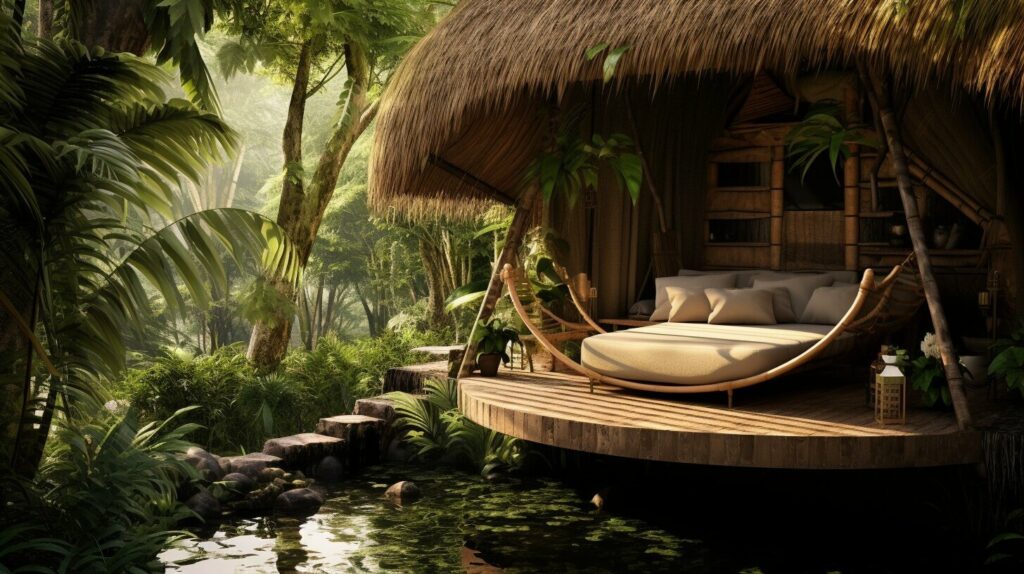
“The construction of eco-friendly jungle shelters is not only essential for survival but also for the wellbeing of our planet.”
When building a jungle shelter, remember that you are part of a larger ecosystem. By choosing sustainable materials, designing an eco-friendly structure, and minimizing your impact, you can help preserve the natural beauty of the jungle for generations to come.
Treehouse Accommodations: A Unique Jungle Shelter Option
When it comes to jungle shelters, treehouses offer a unique and exciting experience. Elevated above the ground, these shelters provide protection from ground-dwelling threats like snakes and insects. Treehouses also offer a sense of connection with nature and a chance to observe jungle wildlife up close.
Treehouse accommodations are becoming increasingly popular, with many eco-friendly and sustainable options available. These shelters are often built with reclaimed wood and other natural materials to minimize their impact on the environment. They can also be designed to be self-sustaining, with features like solar power and rainwater collection systems.
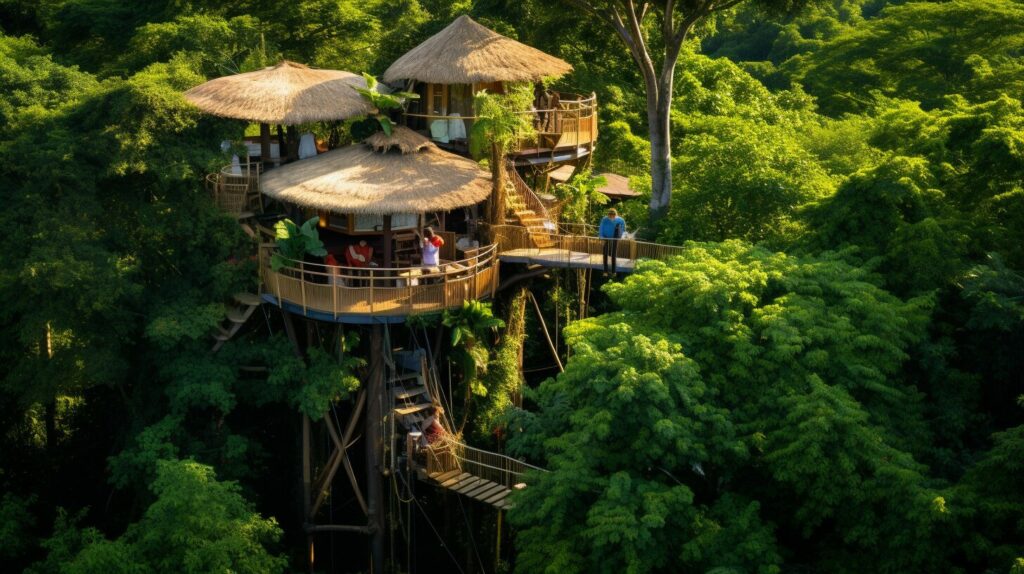
Building a treehouse can be a challenging but rewarding experience. The first step is selecting a suitable tree, one that is strong, healthy, and can support the weight of the shelter. Then, you will need to decide on the design and construction methods, which can vary depending on the tree species and available materials.
Treehouses can be designed to be as simple or as elaborate as you like. Some feature basic designs with just enough space for a bed and basic necessities, while others are multi-level with several rooms and amenities.
Tips for Building a Treehouse
If you’re interested in building a treehouse for your jungle adventure, here are some tips to consider:
- Choose a sturdy tree that is at least 12 inches in diameter and has a healthy root system.
- Use reclaimed or sustainably sourced materials to minimize your environmental impact.
- Consider adding a rainwater collection system and solar panels to make your treehouse self-sustaining.
- Make sure to install safety features like railings and sturdy ladders.
- Be aware of any local treehouse building regulations or permits required.
Overall, treehouse accommodations offer a unique and eco-friendly option for jungle shelters. Whether you’re looking for a simple and rustic design or a luxurious multi-level retreat, a treehouse can provide a comfortable and exciting shelter in the heart of the jungle.
Bamboo Huts: Lightweight and Versatile Shelters
Bamboo is a popular material used in constructing jungle shelters due to its strength and versatility. In this section, you’ll learn about different techniques for building your own bamboo hut and why it’s an excellent choice for a lightweight and eco-friendly shelter.
One of the main advantages of bamboo huts is their ability to withstand harsh weather conditions. Bamboo is not only lightweight, making it easy to transport, but it’s also incredibly durable. The strength of bamboo makes it ideal for creating sturdy structures that can withstand wind, rain, and heat.
| Advantages | Disadvantages |
|---|---|
| Lightweight | Limited headroom |
| Versatile | Requires frequent maintenance |
| Eco-friendly | Mildew and insect-prone |
As the table above shows, bamboo huts have several advantages and disadvantages. While they are lightweight and versatile, they do require frequent maintenance. Additionally, bamboo is prone to mildew and insects, so it’s important to take preventive measures to keep your hut clean and insect-free.
When constructing a bamboo hut, it’s important to follow specific techniques to ensure its stability and longevity. For example, using a bamboo frame and woven bamboo mats for the walls and roof can create a sturdy and weather-resistant shelter.
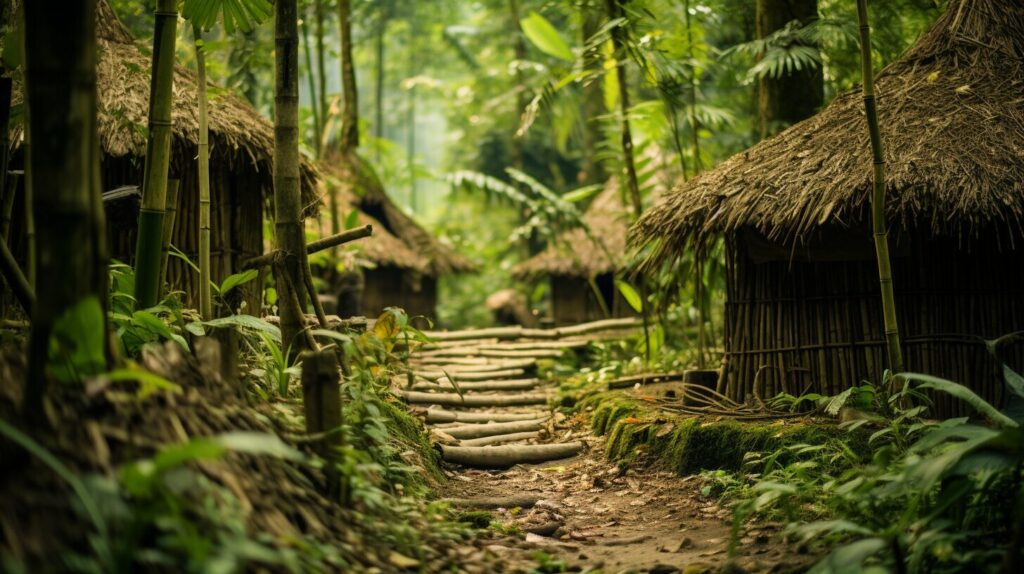
Overall, bamboo huts are an excellent option for creating a lightweight and eco-friendly jungle shelter. By following proper techniques and maintenance, you can create a durable and efficient shelter that will protect you from the elements and minimize your impact on the environment.
Palm Leaf Roof Shelters: Traditional and Effective
Palm leaf roofs have been used for centuries in creating shelters in jungle environments. Palm leaves create an effective barrier against rain and sun, making them an ideal material for roofing.
“The Kalash people of northwest Pakistan have been using palm leaf roofs for centuries, and they still do today,”
says environmentalist and writer, Helena Norberg-Hodge. “They maintain that palm leaf roofs are more effective in keeping the rain out than tin roofs.”
To construct a palm leaf roof shelter, you will need to gather materials such as palm leaves, bamboo, and vine. The first step is to create a sturdy frame out of bamboo or vine, which will serve as the foundation for the roof. Once the frame is in place, you can begin to weave in the palm leaves, using a technique known as thatching.
Thatching involves overlapping layers of palm leaves and securing them to the frame with vine or other natural materials. The result is a durable and effective roof that can withstand harsh jungle conditions.
Advantages of Palm Leaf Roofs
Palm leaf roofs offer several advantages over other types of roofing materials. For one, they are eco-friendly and sustainable, as they are made from natural materials found in the surrounding environment. Additionally, palm leaf roofs are highly effective at keeping rain and sun out, ensuring that the shelter remains dry and cool.
They are also relatively easy to construct and require minimal tools, making them a viable option for emergency shelters or survival situations.
Limitations of Palm Leaf Roofs
While palm leaf roofs are effective at protecting against rain and sun, they do have limitations. One of the main drawbacks is their susceptibility to damage from strong winds and heavy rain. In areas prone to high winds or hurricanes, palm leaf roofs may not be a practical option.
Additionally, palm leaf roofs require regular maintenance, as the leaves will eventually deteriorate and need to be replaced. However, with proper care and maintenance, a palm leaf roof shelter can last for several years.
An Example of a Palm Leaf Roof Shelter
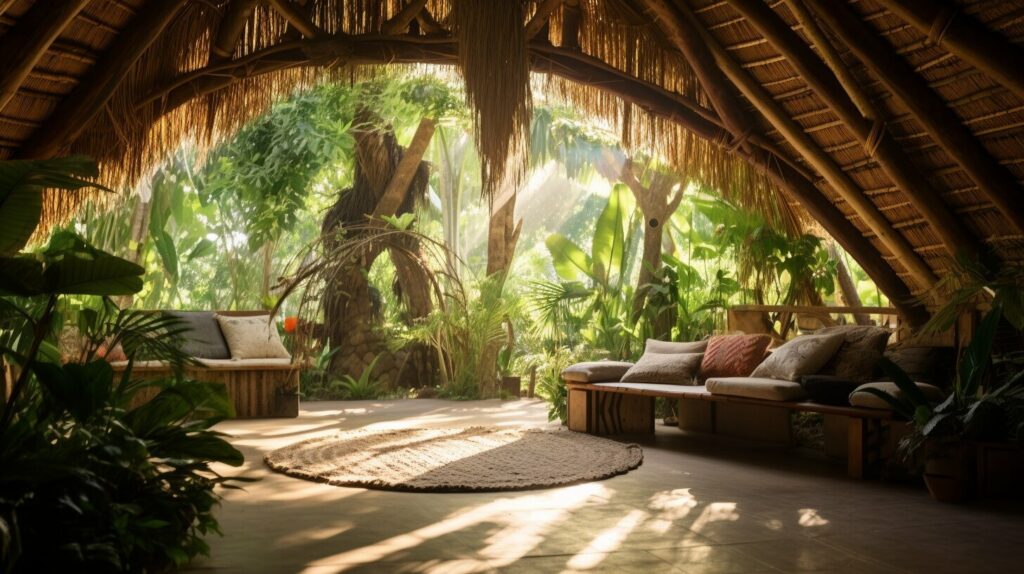
Above is an example of a traditional palm leaf roof shelter built by the Kalash people in northwest Pakistan. Note the use of bamboo and vine for the frame, and the overlapping layers of palm leaves for the roof.
Natural Jungle Retreats: The Beauty of Minimalistic Shelters
If you’re someone who values a simple lifestyle and wants to minimize your impact on the environment, a natural jungle retreat may be the perfect jungle shelter option for you. These rustic shelters are built using natural materials found in the jungle, such as fallen branches, leaves, and vines. While they may not offer the same level of protection as other jungle shelters, they provide a unique connection to nature that is hard to find elsewhere.
One of the advantages of natural jungle retreats is the minimal construction required, which means you can build them quickly and with little effort. Additionally, the materials used are often readily available and can be sourced sustainably, ensuring you’re not harming the jungle ecosystem while creating your shelter.
If you’re interested in building a natural jungle retreat, there are a few techniques to keep in mind. First, consider the site selection carefully. Look for a location that is sheltered from the wind and rain, and ideally near a source of fresh water. You should also choose a level spot to minimize any discomfort while sleeping.
Building Techniques
When it comes to building a natural jungle retreat, there are many techniques you can use. One option is to build a simple lean-to shelter, using fallen branches and leaves to create a roof and walls. Another technique involves constructing a teepee-style shelter using long branches or bamboo poles, which are tied together at the top and covered with leaves or vines.
A popular technique for building a natural jungle retreat is the debris hut, which involves piling branches and other debris against a large tree trunk or rock formation to create a shelter. This technique is especially effective at keeping you warm during colder nights.
Pros and Cons
While natural jungle retreats have many advantages, they also have a few drawbacks. One of the main disadvantages is the lack of protection from ground-dwelling threats such as snakes and insects. Additionally, these shelters provide minimal protection from rain and wind, making them less suitable for extreme weather conditions.
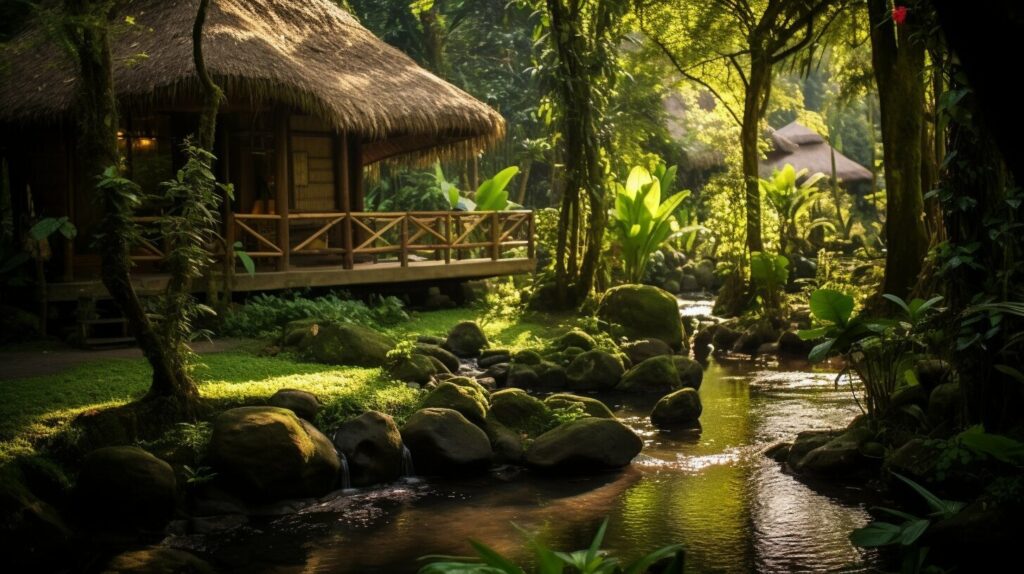
Despite these drawbacks, natural jungle retreats offer a unique experience for those seeking a rustic and minimalistic lifestyle. They provide a connection to nature that is hard to find elsewhere, and with a little creativity and effort, you can create a beautiful and functional shelter using only what the jungle has to offer.
Off-Grid Jungle Homes: Independence in the Wilderness
If you’re looking for a more self-sufficient lifestyle in the jungle, off-grid homes are a great option. These homes provide a unique opportunity to live independently off the land, while reducing your impact on the environment.
Off-grid homes rely on sustainable energy sources like solar panels, wind turbines, and hydroelectric power. They also use techniques like rainwater harvesting and greywater recycling to ensure a consistent supply of clean water.
When building an off-grid home, it’s important to choose a site that maximizes the use of natural resources and minimizes your impact on the environment. Consider the availability of sunlight, wind, and water, as well as the slope and soil quality of the land.
Efficient design principles are also essential for off-grid homes. By designing a home that is both functional and energy-efficient, you can reduce your energy consumption and ensure your home is comfortable year-round. Proper insulation, ventilation, and heating/cooling systems will help keep your off-grid home at a comfortable temperature no matter the weather.
Example of an Off-Grid Home:
| Item | Details |
|---|---|
| Energy source | 10 kW solar panels |
| Water source | Rainwater harvesting and greywater recycling |
| Design features | Passive solar design, triple-paned windows, and a green roof |
| Appliances | Energy Star-rated refrigerator, washing machine, and dishwasher |
| Heating/Cooling | Ground-source heat pump and ceiling fans |
| Toilet | Composting toilet |
An off-grid home may seem like a daunting project, but the benefits are numerous. By living off the grid, you can reduce your reliance on fossil fuels, save money on energy bills, and connect with nature in a unique and meaningful way.
So, if you’re up for the challenge, consider building an off-grid home in the jungle. With a little planning and effort, you can create a sustainable and independent lifestyle that’s in harmony with the natural world.
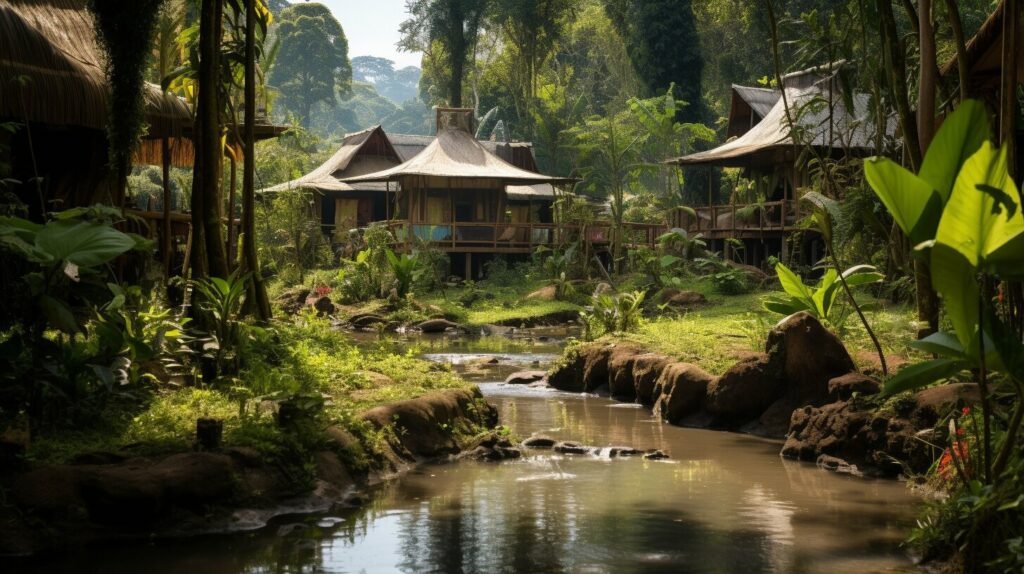
Rustic Jungle Cabins: A Cozy Retreat in the Wilderness
If you’re looking for a way to immerse yourself in the jungle while still enjoying the comforts of home, a rustic jungle cabin might be just what you need. These cabins offer a cozy and comfortable retreat in the heart of the wilderness, with the added benefit of blending seamlessly into the natural surroundings.
One of the advantages of rustic jungle cabins is their versatility. They can be constructed using a variety of materials, from locally sourced wood and bamboo to more modern building materials. The key is to ensure that the cabin is well-insulated and properly ventilated, so that you can stay comfortable no matter the weather.
The Benefits of Rustic Jungle Cabins
Rustic jungle cabins are a popular choice for adventure travelers and nature enthusiasts for several reasons:
- They provide a cozy and comfortable shelter in the wilderness
- They blend seamlessly into the natural surroundings, minimizing your impact on the environment
- They can be constructed using locally sourced materials, making them a sustainable option
But what exactly makes a rustic jungle cabin so unique? For starters, these cabins are often built using traditional construction methods and materials, such as wood, bamboo, and thatch. This gives them a charming, rustic look and feel that is perfect for those seeking a more authentic jungle experience.
In addition, rustic jungle cabins are designed to be self-sufficient and eco-friendly. They often feature solar-powered lighting and water collection systems, as well as composting toilets and other sustainable amenities.
Designing Your Own Rustic Jungle Cabin
Designing your own rustic jungle cabin can be a fun and rewarding experience. Here are some tips to help you get started:
- Choose a location that is well-suited for your cabin, taking into account factors such as accessibility, terrain, and local wildlife.
- Select materials that are sustainable, locally sourced, and appropriate for the climate.
- Design your cabin with comfort and safety in mind, ensuring that it is well-insulated, properly ventilated, and structurally sound.
- Consider incorporating sustainable features such as solar power, rainwater collection, and composting toilets.
- Add personal touches such as decor and furnishings to make your cabin feel like home.
With a little bit of creativity and ingenuity, you can design a rustic jungle cabin that is perfect for your needs and preferences.
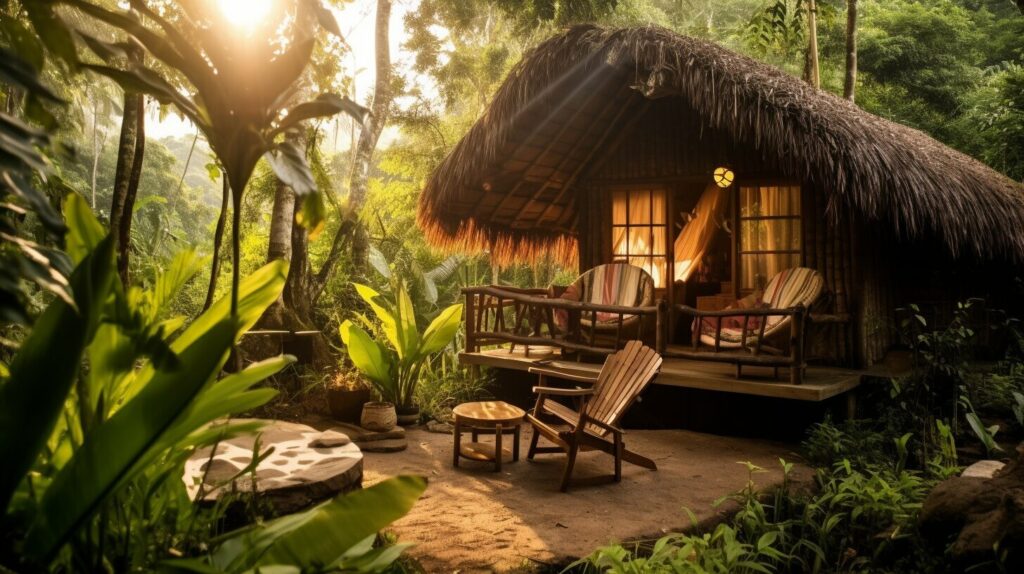
“Rustic jungle cabins offer a cozy and comfortable retreat in the heart of the wilderness, with the added benefit of blending seamlessly into the natural surroundings.”
Whether you’re planning a jungle adventure or just looking for a unique vacation experience, a rustic jungle cabin is a great way to immerse yourself in nature while still enjoying the comforts of home. By choosing sustainable materials and eco-friendly features, you can minimize your impact on the environment and create a shelter that is both cozy and responsible.
Techniques for Building a Jungle Shelter
Building a jungle shelter is essential for survival in the wilderness and requires careful planning and execution. Here are some techniques for building a durable and stable shelter in a tropical rainforest:
Site Selection
When selecting a site for your jungle shelter, look for an area that is dry, level, and away from potential hazards such as falling trees. Avoid building near rivers or streams, as water levels can rise quickly during heavy rains.
Shelter Design
Once you have selected a site, choose a shelter design that is appropriate for the environment. Treehouses are a popular option and provide protection from ground-dwelling threats such as snakes and insects. Bamboo huts are lightweight and versatile, making them a great choice for temporary shelters.
Materials
Choosing the right materials is crucial for building a strong and durable jungle shelter. Look for natural materials that are readily available in the environment, such as bamboo, palm leaves, and vines. These materials are lightweight and easy to work with, but also provide excellent protection from rain and sun.
Construction Techniques
There are several techniques for constructing a jungle shelter, including using natural materials as the framework and weaving palm leaves or other materials for the roof. You can also use cordage or vines to tie the framework together and secure the shelter to nearby trees or other structures.
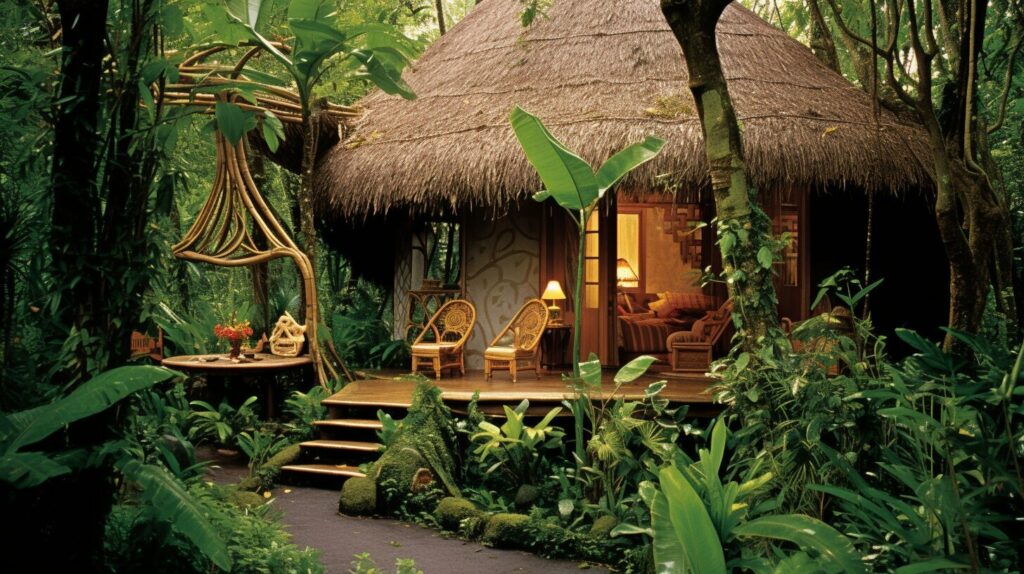
Essential Considerations
When building a jungle shelter, there are several essential considerations to keep in mind. Ensure proper ventilation to prevent the buildup of moisture and humidity. Insulate your shelter to retain heat during cooler temperatures and provide shade during hot weather. Finally, consider potential hazards such as venomous snakes or predatory animals, and take necessary precautions to ensure your safety and the safety of others.
With these techniques in mind, you can build a safe and secure jungle shelter that will protect you from the elements and keep you comfortable during your adventure in the wilderness.
Ensuring Safety and Comfort in Your Jungle Shelter
Building a jungle shelter can be challenging, but it’s crucial to ensure your safety and comfort during your stay in the wilderness. Here are some essential tips:
Insulation and Ventilation
When building a jungle shelter, it’s important to think about insulation and ventilation to keep you comfortable. Insulation helps to maintain a stable temperature inside the shelter, while ventilation allows for airflow to reduce humidity and prevent the growth of mold and mildew.
One way to insulate your shelter is by using natural materials such as leaves or grass, which can trap warm air inside. Additionally, creating vents or windows with mosquito netting can help improve airflow and keep insects out.
Addressing Jungle Hazards
Jungles are full of potential hazards, so it’s important to take precautions when building your shelter. One common threat is poisonous plants, so always be sure to identify and avoid them. Another danger is wildlife, such as snakes or insects, which can easily enter your shelter if not properly sealed.
One way to prevent unwanted visitors is by creating an elevated sleeping area or building your shelter off the ground. Additionally, using mosquito netting or a bug screen around your sleeping area can help keep insects out.
Natural Jungle Retreats
One of the best ways to ensure safety and comfort in the jungle is by opting for a natural jungle retreat. These shelters use natural materials such as leaves, branches, and vines to create a minimalistic, yet effective shelter.
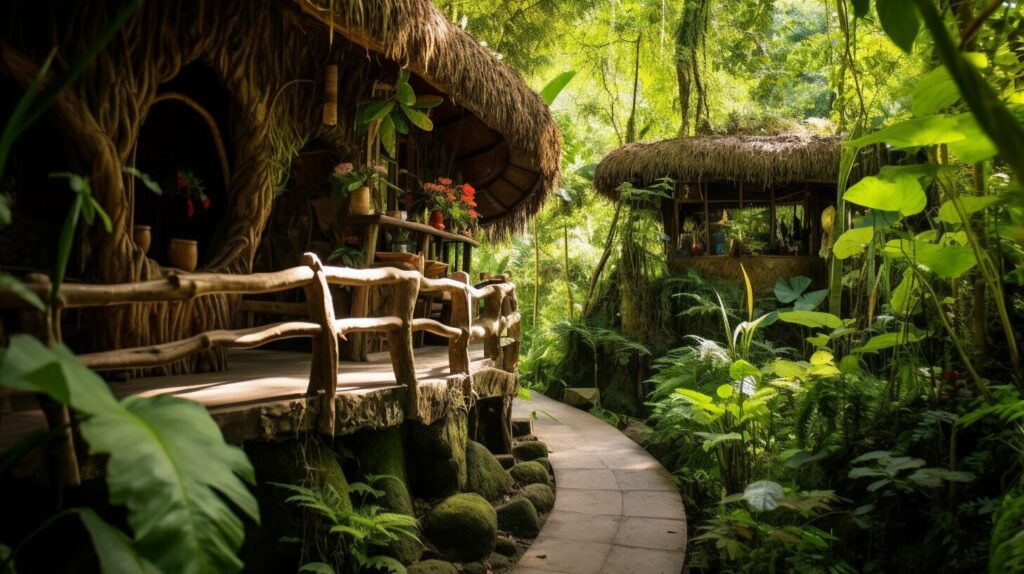
Not only are they eco-friendly, but they also offer a unique and authentic experience in the jungle. By using the resources around you, you can create a shelter that blends seamlessly into your surroundings and provides a comfortable refuge during your jungle adventure.
No matter what type of jungle shelter you choose, it’s important to prioritize your safety and comfort. By following these essential tips, you can build a shelter that not only protects you from the elements but also allows you to enjoy the beauty of the jungle.
Conclusion
In the wilderness, having knowledge of various jungle shelter types is crucial for survival. By understanding different techniques and options, you can build a safe, eco-friendly, and comfortable shelter in any jungle environment. Whether you prefer the unique experience of treehouses, the convenience of bamboo huts, or the simplicity of natural retreats, the key is to adapt to your surroundings and make the most of the resources available to you.
When building your jungle shelter, it’s important to maximize safety and comfort. Make sure your shelter is insulated and well-ventilated to protect yourself from both the elements and potential jungle hazards. Consider your site selection carefully and ensure your shelter is secure and stable. Remember to keep your shelter clean and tidy to avoid attracting animals or insects.
As you embark on your jungle adventure, remember to embrace the experience. Building your own jungle shelter can be a fun and rewarding challenge, and the results can provide you with a safe and comfortable place to rest after a long day of exploring. So, use your knowledge of jungle shelter types and techniques to create your own jungle sanctuary and enjoy the beauty and serenity of the wilderness.
FAQ
What are the different types of jungle shelters?
The different types of jungle shelters include treehouses, bamboo huts, palm leaf roof shelters, natural jungle retreats, off-grid jungle homes, and rustic jungle cabins.
Why are jungle shelters important?
Jungle shelters provide protection from the elements and help minimize your impact on the environment. They are crucial for survival during adventurous expeditions in the jungle.
What are the advantages of treehouse accommodations in the jungle?
Treehouses offer elevated shelters that keep you safe from ground-dwelling threats. They also utilize eco-friendly construction methods.
Why are bamboo huts a popular choice for jungle shelters?
Bamboo huts are lightweight and versatile, making them ideal for jungle environments. They can be constructed using different techniques and provide a sustainable shelter option.
How effective are palm leaf roof shelters in the jungle?
Palm leaf roofs have been used for centuries and provide effective protection against rain and sun in jungle environments. Traditional techniques are employed in constructing these roofs.
What are natural jungle retreats?
Natural jungle retreats are rustic shelters that utilize natural materials and require minimal construction. They offer a simple and eco-friendly option for shelter in the jungle.
What are off-grid jungle homes?
Off-grid jungle homes are self-sufficient shelters that allow you to live independently in the wilderness. They utilize sustainable energy sources, water collection systems, and efficient design principles.
What makes rustic jungle cabins a cozy retreat?
Rustic jungle cabins offer a comfortable shelter in the heart of the wilderness. They are constructed using specific materials and techniques that create a cozy and charming atmosphere.
What techniques are used for building jungle shelters?
Techniques for building jungle shelters include site selection, shelter design, and essential considerations for constructing a safe and secure shelter in tropical rainforests.
How can I ensure safety and comfort in my jungle shelter?
To maximize safety and comfort in your jungle shelter, consider insulation, ventilation, and addressing potential jungle hazards. Adapt to your surroundings and make the most of available resources.

